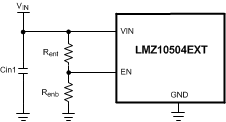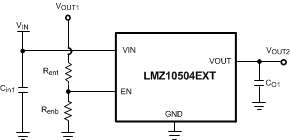SNVS670J June 2010 – April 2019 LMZ10504EXT
PRODUCTION DATA.
- 1 Features
- 2 Applications
- 3 Description
- 4 Revision History
- 5 Pin Configuration and Functions
- 6 Specifications
- 7 Detailed Description
- 8 Application and Implementation
- 9 Power Supply Recommendations
- 10Layout
- 11Device and Documentation Support
- 12Mechanical, Packaging, and Orderable Information
Package Options
Mechanical Data (Package|Pins)
- NDW|7
Thermal pad, mechanical data (Package|Pins)
Orderable Information
7.3.2 Enable and UVLO
Using a resistor divider from VIN to EN as shown in the schematic diagram below, the input voltage at which the part begins switching can be increased above the normal input UVLO level according to:
For example, suppose that the required input UVLO level is 3.69 V. Choosing Renb = 10 kΩ, then we calculate Rent = 20 kΩ.
 Figure 16. Setting Enable and UVLO
Figure 16. Setting Enable and UVLO Alternatively, the EN pin can be driven from another voltage source to cater to system sequencing requirements commonly found in FPGA and other multi-rail applications. Figure 17 shows an LMZ10504EXT that is sequenced to start based on the voltage level of a master system rail (VOUT1).
 Figure 17. Setting Enable and UVLO Using External Power Supply
Figure 17. Setting Enable and UVLO Using External Power Supply 